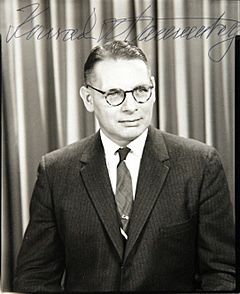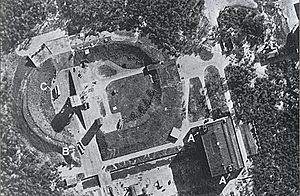Konrad Dannenberg facts for kids
Quick facts for kids
Konrad Dannenberg
|
|
|---|---|
 |
|
| Born | August 5, 1912 Weißenfels, Province of Saxony, German Empire
|
| Died | February 16, 2009 (aged 96) Huntsville, Alabama, United States
|
| Alma mater | University of Hannover |
| Occupation | Rocket engineer and designer |
| Spouse(s) | Ingeborg M. Kamke Jacquelyn E. Staiger |
| Children | 1 |
Konrad Dannenberg (born August 5, 1912 – died February 16, 2009) was a German-American rocket expert. He was a key member of the German rocket team. This team came to the United States after World War II to help with space exploration.
Contents
Early Life and Rocket Dreams
Konrad Dannenberg was born in Weißenfels, Germany. When he was two, his family moved to Hannover, where he grew up. He became very interested in space technology. This happened after he heard a talk by Max Valier, an early German space pioneer.
Konrad even saw tests of a special railroad car powered by rockets. He then joined a group of amateur rocket builders led by Albert Püllenberg. Konrad studied mechanical engineering at the University of Hannover. He focused on how fuel is injected into engines. He knew this skill would be important for powerful rocket engines.
In 1939, when World War II began, Dannenberg joined the German Army. He served in an artillery unit. He also took part in the early battles in France.
Building Rockets in Peenemünde
In 1940, Konrad Dannenberg left the army. He started working at the Peenemünde Army Research Center in Germany. This was a secret place where rockets were developed. He became a rocket engine expert under Walter Thiel.
His main job was to create a powerful engine for the V-2 ballistic missile. On October 3, 1942, he saw a V-2 rocket launch. This was the first man-made object to reach outer space. It went above 50 miles in altitude, which was considered space at the time.
Konrad worked on many improvements for the V-2. However, these changes could not be finished before the rockets went into production. After Walter Thiel died in a bombing raid, all new development stopped. Dannenberg then helped finalize the drawings for the V-2. This was the world's first ballistic missile.
Moving to the United States
After World War II, Konrad Dannenberg came to the United States. He was one of 118 German scientists brought over in Operation Paperclip. They first went to Fort Bliss, Texas. There, they worked on designs for future rockets. These rockets would fly farther and carry more weight.
About 30 scientists also helped train the U.S. Army to launch V-2 rockets. These launches happened at the White Sands Proving Ground. The rockets were launched straight up to study the upper atmosphere. This was a big step for space research.
When the Korean War started, the team moved to Redstone Arsenal in Huntsville, Alabama. Their first project was developing the PGM-11 Redstone Missile. Wernher von Braun, another rocket pioneer, decided to buy the Redstone engine from a company called North American Aviation (NAA).
Konrad Dannenberg became the link between the Army and NAA. He helped get rocket engines for the Redstone and the Jupiter IRBM missiles. He also oversaw the production of these missiles at the Chrysler plant in Detroit, Michigan.
Working with NASA
In 1960, Dannenberg joined NASA's new Marshall Space Flight Center. He became the Deputy Manager of the Saturn program. In 1973, he received the NASA Exceptional Service Medal. This award was for his important role in starting the development of the Saturn V rocket.
The Saturn V was the largest rocket ever built. It was the rocket that took the first humans to the Moon. After this, Dannenberg started working on ideas for space stations. These stations would have been based on the Saturn rockets. Later, the Space Shuttle and the ISS took their place.
Life After Retirement
Konrad Dannenberg retired from NASA in 1973. He then became a professor at the University of Tennessee Space Institute. He taught about aerospace engineering.
He was a respected member of the American Institute of Aeronautics and Astronautics. He also received important awards, like the DURAND Lectureship in 1990 and the Hermann Oberth Award in 1996.
Konrad loved to share his knowledge. He gave talks about basic rocketry at the United States Space Camp. In 1992, the Alabama Space and Rocket Center created a scholarship in his honor. It gives young people free entry to a Space Academy session.
Personal Life
Konrad Dannenberg had a son, Klaus Dieter, with his first wife, Ingeborg M. Kamke (now deceased). He had two grandchildren and four great-grandchildren. He later married Jacquelyn E. Staiger.
Konrad Dannenberg passed away in Huntsville, Alabama, on February 16, 2009. He was 96 years old. He is buried at Maple Hill Cemetery.
Images for kids





